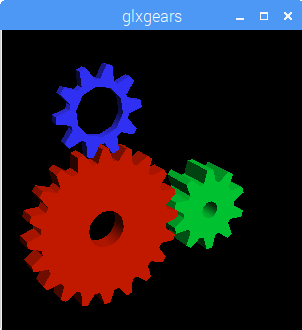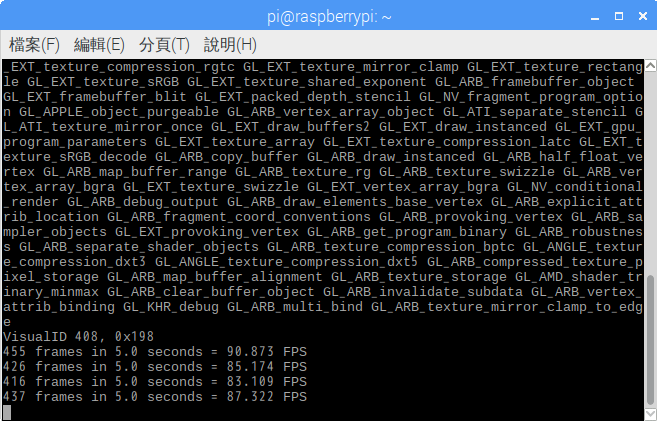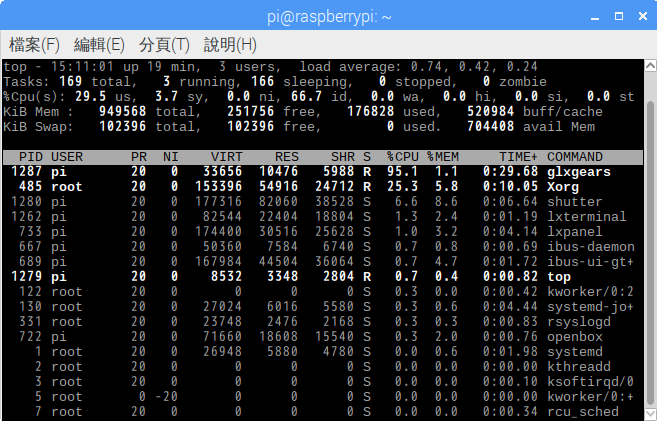『事』從吏字分化出來,表示傳達命令並且監督實施。人『行』到縱橫暢通的十字路口 ,或將有所作為乎?
事要是真的能行,行事『前』的『規劃』不能少,期『中』 必須要『監督』實施,事行『後』一定得『檢驗』是否『符合規劃 』。
……
【怎麼會發生回歸錯誤?】
當一個軟體『變大』『變複雜』的時候,即使好好的『測試』,也難保沒有『錯誤』。以致針對『已知的』臭蟲必須『除錯』。只是除錯這一件事遠比想像的『困難』,常常『改好了這個』卻又『發生了那個』。又有時『修正新錯誤』反而使得『原先沒問題』的倒是『產生了狀況』,這種情形就叫做『回 歸錯誤』Regression Fail!!玩新版 B+ 如果遇到這事,不要覺的奇怪!!
─── 《媒體中心──行事》
回顧三年前樹莓派革故 B 鼎新 B+ 之時,也曾遭遇回歸性錯誤!不知今日論壇上何事劍拔弩張?
Re: Mesa driver much slower on Stretch than on Jessie
Tue Sep 05, 2017 2:16 pmI inclined think the best thing would be to remove the entire slow MESA package from our Stretch, that way people won’t think we are responsible for it when we clearly are not. Not sure how easy that is to do, and it might set a bad precedent – there are quite a few packages that you can easily install that don’t work – don’t want to have to remove all of them, maintenance would be horrendous.
It’s the same package that is responsible for the handling opengl for the vc4 driver. It just uses software rendering if no hardware acceleration is available.
……
Re: Mesa driver much slower on Stretch than on Jessie
RichardRussell wrote: ↑
Tue Sep 05, 2017 11:36 amI am unclear to what extent Debian support the armhf architecture. If they do, then absolutely it should be their responsibility to fix issues in packages not supplied by the RPF. But if they don’t, and a regression affects only ARM platforms like the Raspberry Pi, then there’s a danger of nobody accepting ownership of the problem.
Welcome to the world of Open source software…
It is the ‘responsibility’ of the package maintainer to test and ensure their software works correctly. But if they are not interested in ARM devices, they are under no obligation to fix any issues that may occur on the ARM platform. It’s not like they are making any money off the software, or are being paid to maintain it.
I can hear to incoming comment “But the RPF makes money from the software”. This isn’t true. We make money from selling HW, nothing from software. Although there is an interesting calculation you can make. Lets say the RPF make ![]() 5/26000 of that profit, IFF we made money only on the SW, per package, multiplied by the total number of Pi’s sold (14m) = about
5/26000 of that profit, IFF we made money only on the SW, per package, multiplied by the total number of Pi’s sold (14m) = about ![]() 2700. Which is few days of engineering time. And that assumes every single Pi runs that package. OK, so its a dodgy calculation, but gives some idea of the cost benefit analysis of where we need to put engineering effort.
2700. Which is few days of engineering time. And that assumes every single Pi runs that package. OK, so its a dodgy calculation, but gives some idea of the cost benefit analysis of where we need to put engineering effort.
當此鼎革革鼎之際,莫若面對問題︰
Re: Mesa driver much slower on Stretch than on Jessie
I was able to improve MESA performance 2x by regressing to the jessie version of one of the libraries, while still running stretch:
Bare stretch:
glxgears -info
123 frames in 5.0 seconds = 24.481 FPSedit /etc/apt/sources.list to add this at the end:
deb http://mirrordirector.raspbian.org/raspbian/ jessie main contrib non-free rpinow revert to the jessie version:
sudo apt-get update
sudo apt-get install libgl1-mesa-dri=10.3.2-1+deb8u1
sudo apt-mark hold libgl1-mesa-drithis DOUBLES the framerate of glxgears from 24 fps to 53 fps on my pi2 (and corrects the colours too)
glxgears -info
269 frames in 5.0 seconds = 53.790 FPS[edit]
if you want to return to the most recent (slow) version for any reason, do this:
sudo apt-mark unhold libgl1-mesa-dri
sudo apt-get upgrade
嘗試釐清原由︰
pi@raspberrypi:~![Rendered by QuickLaTeX.com sudo apt-get install libgl1-mesa-dri=10.3.2-1+deb8u1 正在讀取套件清單... 完成 正在重建相依關係 正在讀取狀態資料... 完成 下列的額外套件將被安裝: libllvm3.5 下列【新】套件將會被安裝: libllvm3.5 下列套件將會被【降級】: libgl1-mesa-dri 升級 0 個,新安裝 1 個,降級 1 個,移除 0 個,有 21 個未被升級。 需要下載 9,119 kB 的套件檔。 此操作完成之後,會空出 76.0 MB 的磁碟空間。 是否繼續進行 [Y/n]? [Y/n] 下載:1 http://mirrordirector.raspbian.org/raspbian jessie/main armhf libllvm3.5 armhf 1:3.5-10+rpi1 [6,644 kB] 下載:2 http://mirrordirector.raspbian.org/raspbian jessie/main armhf libgl1-mesa-dri armhf 10.3.2-1+deb8u1 [2,476 kB] 取得 9,119 kB 用了 3min 18s (46.0 kB/s) 選取了原先未選的套件 libllvm3.5:armhf。 (讀取資料庫 ... 目前共安裝了 276416 個檔案和目錄。) Preparing to unpack .../libllvm3.5_1%3a3.5-10+rpi1_armhf.deb ... Unpacking libllvm3.5:armhf (1:3.5-10+rpi1) ... dpkg: 警告: 將 libgl1-mesa-dri:armhf 從 13.0.6-1+rpi2 降級到 10.3.2-1+deb8u1 Preparing to unpack .../libgl1-mesa-dri_10.3.2-1+deb8u1_armhf.deb ... Unpacking libgl1-mesa-dri:armhf (10.3.2-1+deb8u1) over (13.0.6-1+rpi2) ... 設定 libllvm3.5:armhf (1:3.5-10+rpi1) ... 設定 libgl1-mesa-dri:armhf (10.3.2-1+deb8u1) ... 安裝新版的設定檔 /etc/drirc ... pi@raspberrypi:~](http://www.freesandal.org/wp-content/ql-cache/quicklatex.com-2427513daf4f2326ff7893947690000b_l3.png)
或許可見曙光︰



知道方向︰
pi@raspberrypi:~
踏出關鍵一步耶☆
OpenGL ES
Mesa implements OpenGL ES 1.1 and OpenGL ES 2.0. More information about OpenGL ES can be found at https://www.khronos.org/opengles/.
OpenGL ES depends on a working EGL implementation. Please refer to Mesa EGL for more information about EGL.
Build the Libraries
- Run
configurewith--enable-gles1 --enable-gles2and enable the Gallium driver for your hardware. - Build and install Mesa as usual.
Alternatively, if XCB-DRI2 is installed on the system, one can use egl_dri2 EGL driver with OpenGL|ES-enabled DRI drivers
- Run
configurewith--enable-gles1 --enable-gles2. - Build and install Mesa as usual.
Both methods will install libGLESv1_CM, libGLESv2, libEGL, and one or more EGL drivers for your hardware.
Developers
Dispatch Table
OpenGL ES has an additional indirection when dispatching functions
Mesa: glFoo() –> _mesa_Foo()
OpenGL ES: glFoo() –> _es_Foo() –> _mesa_Foo()
The indirection serves several purposes
- When a function is in Mesa and the type matches, it checks the arguments and calls the Mesa function.
- When a function is in Mesa but the type mismatches, it checks and converts the arguments before calling the Mesa function.
- When a function is not available in Mesa, or accepts arguments that are not available in OpenGL, it provides its own implementation.
Other than the last case, OpenGL ES uses APIspec.xml to generate functions to check and/or converts the arguments.

OpenGL ES API Versions at a Glance
OpenGL ES 3.2 – Additional OpenGL functionality
The latest in the series, OpenGL ES 3.2 added additional functionality based on the Android Extension Pack for OpenGL ES 3.1, which brought the mobile API’s functionality significantly closer to it’s desktop counterpart – OpenGL.
OpenGL ES 3.1 – Bringing Compute to Mobile Graphics
Despite being only a bump in the minor revision of the API, OpenGL ES 3.1 was an enormous milestone for the API, as it added the ability to do general purpose compute in the API, bringing compute to mobile graphics.
OpenGL ES 3.0 – Enhanced Graphics
OpenGL ES 3.0 was another evolutionary step for OpenGL ES, notably including multiple render targets, additional texturing capabilities, uniform buffers, instancing and transform feedback.
OpenGL ES 2.0 – Programmable Shading
OpenGL ES 2.0 was the first portable mobile graphics API to expose programmable shaders in the then latest generation of graphics hardware. It remains a prevalent API today, and still is the most widely available 3D graphics API, and remains a solid choice to target the widest range of devices in the market.
OpenGL ES 1.X – Fixed Function Graphics
OpenGL ES 1.0 and 1.1 were the first portable mobile graphics APIs, defined relative to the OpenGL 1.5 specification, providing fixed function graphics acceleration
您在所有發行版中所有硬體架構下所有區域里,指定關鍵字 libgl1-mesa-dri 在套件名稱中搜尋的結果。 找到 5 個匹配的套件。
完整匹配
套件 libgl1-mesa-dri
- wheezy (oldoldstable) (libs): free implementation of the OpenGL API — DRI modules
8.0.5-4+deb7u2: amd64 armel armhf i386 ia64 kfreebsd-amd64 kfreebsd-i386 mips mipsel powerpc s390 s390x sparc - jessie (oldstable) (libs): free implementation of the OpenGL API — DRI modules
10.3.2-1+deb8u1: amd64 arm64 armel armhf i386 mips mipsel powerpc ppc64el s390x - jessie-backports (libs): free implementation of the OpenGL API — DRI modules
13.0.6-1~bpo8+1: amd64 arm64 armel armhf i386 mips mipsel powerpc ppc64el s390x - stretch (stable) (libs): free implementation of the OpenGL API — DRI modules
13.0.6-1+b2: amd64 arm64 armel armhf i386 mips mips64el mipsel ppc64el s390x - buster (testing) (libs): free implementation of the OpenGL API — DRI modules
17.2.3-1: amd64 arm64 armel armhf i386 mips mips64el mipsel ppc64el s390x - sid (unstable) (libs): free implementation of the OpenGL API — DRI modules
17.2.4-1: alpha amd64 arm64 armel armhf hppa i386 m68k mips mips64el mipsel powerpc powerpcspe ppc64 ppc64el s390x sparc64 x32
13.0.6-1: hurd-i386
12.0.4-2: kfreebsd-amd64 kfreebsd-i386
11.2.2-1 [debports]: sh4 - experimental (rc-buggy) (libs): free implementation of the OpenGL API — DRI modules
17.3.0~rc2-1: amd64 arm64 armel armhf hppa i386 m68k mips powerpc ppc64 ppc64el s390x sparc64

